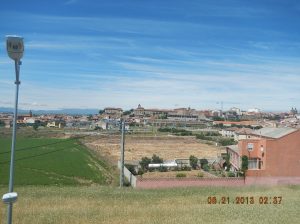CLICK ON THE PICTURES TO ENLARGE TO FULL-SIZE
Astorga is not only famous for its past as an old Roman fortified city on a steep ridge; it is also famous for being a center – some say the “capital” of the Maragatería. The Maragatos are a mystery. This small ethnic and cultural community of about 4,000, scattered in forty villages around and from Astorga to Molinesca, are of uncertain origin. Many, many theories abound as to their identity. It has been speculated that they are a “remanent” of Astures, Berbers, Visigoths or Carthaginians. Some think that they descend from the Goths who sided with the Muslims during their 8th century invasion of Spain and that they adopted their religion, dress (tight bloomer pants, large belts and big hats) and customs as a result. They are also some that believe the reason for their name is that they descend from a legendary Visigothic King named Mauregato while others speculate that they are an isolated group of Mozarabs. A school of thought believes that the rocky soil of these mountains forced them to become carters or muleteers in order to survive and that this led to the Romans calling them mercator, or merchants – and somehow this name may have stuck. For a change, Laureano Rubio of the Universidad de León posits that the name maragato stems from the time that these people were famous as merchants or transporters of salty fish from Galicia (el Mar, meaning the Sea) to (“a” being the Spanish word for to) Madrid (los Gatos, meaning the cats). Hence Mar + a + gatos = Maragatos! Entertaining but unlikely!
Whatever their origin they had a distinctive dress – the men (as late as the 19th century) would have worn wide breeches, white shirts, red garters and slouch hats. One would have seen women with crescent hats, lacy mantles, heavy black shirts and intricate filigree earrings.
Link to pictures of traditional Maragato costumes
Their low stone houses – called teitadas – have roofs of locally mined slate or have thatched roofs (less common these days). The doors of these houses are large with a large stone being often placed outside the door to serve as a bench while the windows are small in order to preserve heat.
Link to an example of a Maragato house
Now we come to the food of the Maragateria. While reading about the area in Brierley’s guide I came across a sentence that described the cocido maragato or maragato stew. He had this to say about it:
…try some of the local cuisine cocido maragato which starts with a hearty meat stew, usually pork and black pudding with beans and cabbage followed by vegetables and finished off with a bowl of broth!
The day that we arrived in Astorga I was determined to try the cocido maragato and since we arrived at about 2 p.m. (a very Spanish time to eat lunch) I was able to somehow convince my new-found friends to join me. Luckily for us we quickly found a restaurant in the Plaza San Bartolomé that specialized in maragato cuisine. The cocido maragato while being a hearty meat stew (this was because it served as the one and only meal for laborers) it is one that utilizes all the least desirable cuts, for example the internal organs of the animal. This stew is in effect a stew that is served in reverse. First you get the meats, then comes the beans and vegetables and lastly you are served the broth. We gamely tried to eat some of it but it is definitely an acquired taste. When in Rome or When in Roman Astorga…




